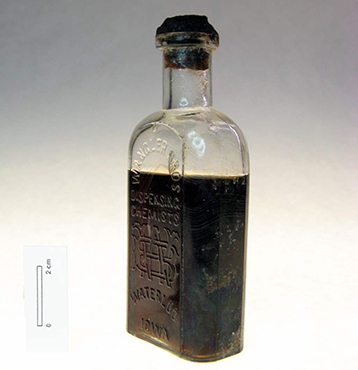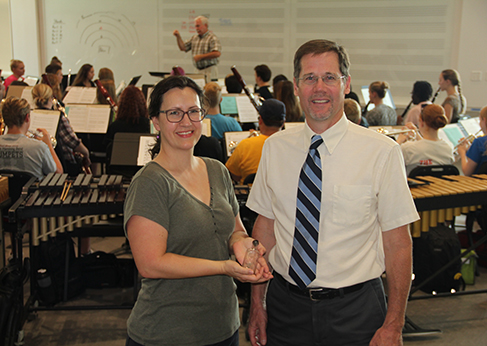
| Oct. 2016 | |||||||||||
| Top stories | |||||||||||
| In the news | |||||||||||
| Photos | |||||||||||
| Contact us | |||||||||||
| Archive | |||||||||||
|
State archaeologists and lab confirm time in a bottle |
Iowa City was a rapidly developing urban center in 1910. The River to River Road – now Highway 6 – was improved, making it possible to drive an automobile from the Mississippi River to the Missouri River. The CRANDIC interurban railway carried passengers between Cedar Rapids and Iowa City. The University of Iowa celebrated its 63rd anniversary, and the Iowa Law School moved into the newly constructed Gilmore Hall.
 This bottle of carbolic acid was found at the construction site of the Voxman Music Building at South Clinton and Burlington in Iowa City. Testing by the State Hygienic Laboratory's Environmental Health Division identified the liquid as carbolic acid, a toxic substance used as an antiseptic at the beginning of the 20th century.
This bottle of carbolic acid was found at the construction site of the Voxman Music Building at South Clinton and Burlington in Iowa City. Testing by the State Hygienic Laboratory's Environmental Health Division identified the liquid as carbolic acid, a toxic substance used as an antiseptic at the beginning of the 20th century.In the Medical Laboratory building at the corner of Dubuque and Jefferson streets, Dr. Henry Albert and three colleagues worked in the Iowa Bacteriological Laboratory, testing for common diseases of the day: diphtheria, typhoid, rabies and tuberculosis.
Five blocks away at 323 South Clinton Street students studied and families raised their children in the multi-tenant house. Some of these residents likely walked by the Bacteriological Laboratory (now the State Hygienic Laboratory) on a regular basis or, perhaps, were taught bacteriology by Dr. Albert, the lab’s first director.
Although the State Hygienic Laboratory moved miles away to the Oakdale Campus in Coralville (now the UI Research Park) in the late 1970s, a close connection with that South Clinton site remains.
Displacement
Hancher Auditorium was one of the most visible victims of the 2008 flood. Less obvious was the School of Music, then located in the Voxman Music Building, adjacent to Hancher, and likewise destroyed by the flood.
The Federal Emergency Management Agency (FEMA) agreed to provide funding for a new School of Music building, and in 2011, the lot at 323 South Clinton Street was chosen. That stretch of South Clinton near Burlington has had a long history with some buildings dating back as far as 1845: a Presbyterian church, a grain warehouse, a feed mill, a multi-tenant house and, more recently, a parking lot and a bank.
Before construction began at the site on the southwest corner of Clinton and Burlington streets, Angela Collins, project archaeologist, and her colleagues at the University of Iowa Office of the State Archaeologist (OSA) identified four intact archaeological features. The oldest was a small limestone foundation with two nearby privies. There was also a limestone-lined well containing a “startling number of bottles” and other miscellaneous artifacts from the early 20th century.
 Angela Collins of the Office of the State Archaeologist and Terry Cain, environmental lab supervisor, pose in front of a University of Iowa student orchestra class in the Voxman Music Building. She holds the glass bottle found during the construction of the building.
Angela Collins of the Office of the State Archaeologist and Terry Cain, environmental lab supervisor, pose in front of a University of Iowa student orchestra class in the Voxman Music Building. She holds the glass bottle found during the construction of the building.One in a hundred
In almost every case, glass bottles recovered from an archaeological context are either empty or broken. One exception was a bottle from the Clinton Street site that contained an unknown dark liquid that was well sealed with a cork. The archaeologists knew from its embossed label that the liquid was a proprietary medicine likely mixed in the late 1800s or early 1900s at a pharmacy in Waterloo, and perhaps available on its shelves. No other clues led to solving the mystery of what was in the bottle. The OSA contacted Hygienic Laboratory’s Terry Cain, environmental lab supervisor, to find out.
“To my knowledge, this sample is the oldest manmade product we have ever tested,” Cain said of the dark liquid. “The cork was severely weathered, and not knowing if the glass was fragile, I wanted to be very cautious to not cause any damage. Realizing its age and speculating about how or why it was dropped into the privy added to the suspense while conducting our observations.”
The liquid tested positive for carbolic acid, a lethal substance extracted from coal tar or petroleum and used in the 19th and early 20th centuries as an antiseptic.
“Carbolic acid, also known as phenol, is not commonly found in the environment,” Cain said. “But it is utilized today in large scale production for various industries and, as such, we routinely include it as a targeted toxic chemical [that is specifically looked for] in our testing.”
Parallel paths
The history of the bottle and its contents links the State Hygienic Laboratory and its Environmental Health Division to a historic era in Iowa City with a parallel path to the early days of public health testing.
“This project gave us a chance to have a connection with some fellow Iowans of the 20th century and a little window into their lives,” Cain said. “Lesson learned: If you find an old bottle with something in it, don’t assume it’s not dangerous.”
The Office of the State Archaeologist has recommended this archaeological site as eligible for listing on the National Register of Historic Places. In the meantime, the now empty medicine bottle is back at is South Clinton Street home, in a display case in the University of Iowa’s new Voxman Music Building.
“Well, it’s always pretty interesting as an archaeologist to discover something you haven’t known before,” Collins said. “Intact contents are like, ‘Oh, I wonder what it could be?’
“I always wondered if it was an internal medicine. I wasn’t really expecting something like carbolic acid, but that forced me to look into its uses in medicine, and I don’t think it’s well-known.
“So this could really provide something new, I think, for general understanding for archaeologists and historians.”